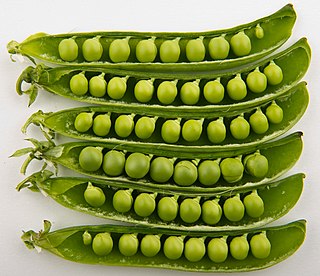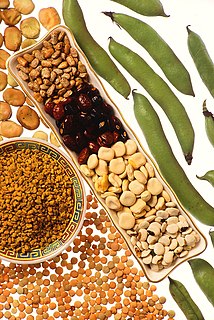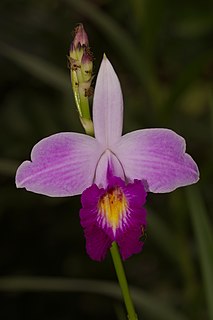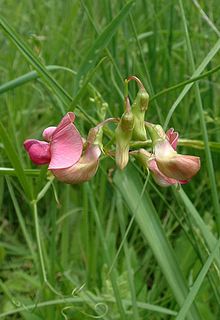
The pea is most commonly the small spherical seed or the seed-pod of the pod fruit Pisum sativum. Each pod contains several peas, which can be green or yellow. Botanically, pea pods are fruit, since they contain seeds and develop from the ovary of a (pea) flower. The name is also used to describe other edible seeds from the Fabaceae such as the pigeon pea, the cowpea, and the seeds from several species of Lathyrus.

A legume is a plant in the family Fabaceae, or the fruit or seed of such a plant. When used as a dry grain, the seed is also called a pulse. Legumes are grown agriculturally, primarily for human consumption, for livestock forage and silage, and as soil-enhancing green manure. Well-known legumes include beans, soybeans, peas, chickpeas, peanuts, lentils, lupins, mesquite, carob, tamarind, alfalfa, and clover. Legumes produce a botanically unique type of fruit – a simple dry fruit that develops from a simple carpel and usually dehisces on two sides.

The mung bean, alternatively known as the green gram, maash, moong, monggo, or munggo (Philippines), is a plant species in the legume family. The mung bean is mainly cultivated in East, Southeast and South Asia. It is used as an ingredient in both savoury and sweet dishes.

The cowpea is an annual herbaceous legume from the genus Vigna. Due to its tolerance for sandy soil and low rainfall, it is an important crop in the semiarid regions across Africa and Asia. It requires very few inputs, as the plant's root nodules are able to fix atmospheric nitrogen, making it a valuable crop for resource-poor farmers and well-suited to intercropping with other crops. The whole plant is used as forage for animals, with its use as cattle feed likely responsible for its name.

Vigna is a genus of flowering plants in the legume family, Fabaceae, with a pantropical distribution. It includes some well-known cultivated species, including many types of beans. Some are former members of the genus Phaseolus. According to Hortus Third, Vigna differs from Phaseolus in biochemistry and pollen structure, and in details of the style and stipules.

The winged bean, also known as cigarillas, goa bean, four-angled bean, four-cornered bean, manila bean, princess bean, asparagus pea, dragon bean, is a tropical herbaceous legume plant. In Indonesia, it is known as kecipir. Its origin is most likely New Guinea.

The asparagus bean is a legume cultivated for its edible green pods containing immature seeds, like the green bean. It is also known as: yardlong bean, pea bean, long-podded cowpea, Chinese long bean, snake bean, bodi, and bora. Despite the common name of "yardlong", the pods are actually only about half a yard long, so the subspecies name sesquipedalis is a more accurate approximation.

Arundina graminifolia is a species of orchid and the sole accepted species of the genus Arundina. This tropical Asiatic genus extends from Myanmar, India, Sri Lanka, Nepal, Thailand, Vietnam, the Ryukyu Islands, Malaysia, Singapore, China to Indonesia, the Philippines and New Guinea. It has become naturalized in Réunion, Fiji, French Polynesia, Micronesia, the West Indies, Costa Rica, Panama and Hawaii. It is also called bamboo orchid.

Millettia pinnata is a species of tree in the pea family, Fabaceae, native to eastern and tropical Asia, Australia, and Pacific islands. It is often known by the synonym Pongamia pinnata. Its common names include Indian beech and Pongame oiltree.

Lathyrus sylvestris, the flat pea or narrow-leaved everlasting-pea, is a plant species of the genus Lathyrus. It is native to parts of Africa, Europe, and Asia.

Lathyrus palustris is a species of wild pea known by the common name marsh pea. It is native to Europe, Asia, and North America. It is a perennial herb with leaves made up of oval-shaped or oblong leaflets a few centimeters long. It has branched, coiled tendrils. The plant bears an inflorescence of two to eight pinkish purple pea flowers each up to two centimeters wide. The fruit is a dehiscent legume pod.

Maruca vitrata is a pantropical insect pest of leguminous crops like pigeon pea, cowpea, mung bean and soybean. Its common names include the maruca pod borer, bean pod borer, soybean pod borer, mung moth, and the legume pod borer. The species was first described by Johan Christian Fabricius in 1787.

Guilandina bonduc, commonly known as grey nicker, nicker bean, fever nut or knicker nut, is a species of flowering plant in the senna tribe, Caesalpinieae, that has a pantropical distribution. It is a liana that reaches a length of 6 m (20 ft) or more and scrambles over other vegetation. The stems are covered in curved spines. Its 2 cm (0.8 in) grey seeds, known as nickernuts, are buoyant and durable enough to be dispersed by ocean currents.
The Dixie Lee Pea is an Heirloom variety of cowpea popular in the Carolinas, although prevalent throughout most of the American south.

Vigna owahuensis is a rare species of flowering plant in the legume family known by the common name Oahu cowpea.
Pea beans are several types of common food plants producing beans:

Aeschynomene indica is a species of flowering plant in the legume family. Common names include Indian jointvetch, kat sola, budda pea, curly indigo, hard sola, northern jointvetch, indische Schampflanze (German), angiquinho, maricazinho, papquinha, pinheirinho, he meng (Chinese), kusanemu (Japanese), diya siyambala (Sinhala), and ikin sihk (Pohnpeian).

Vigna angularis, also known as the adzuki bean(Japanese: 小豆, azuki, Uncommon アヅキ, adzuki), azuki bean, aduki bean, red bean, or red mung bean, is an annual vine widely cultivated throughout East Asia for its small bean. The cultivars most familiar in East Asia have a uniform red color, but there are also white, black, gray, and variously mottled varieties.

Vigna luteola, commonly known as the hairy cowpea, is a perennial vine found in many tropical areas.

Vigna hosei, also known as the sarowak bean, is a perennial legume that grows in low-lying, humid, tropical areas but more commonly disturbed or roadside areas.



















